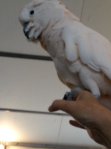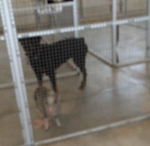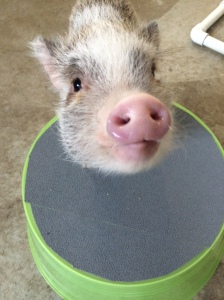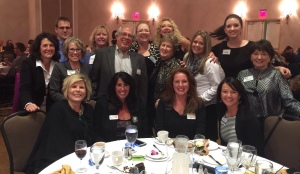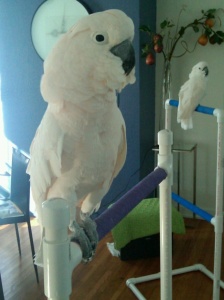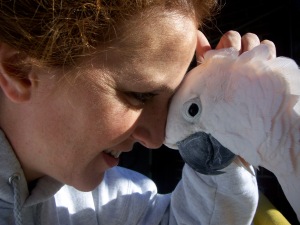Search Results
An Everyday Training Example Here at The Animal Behavior Center
I took this video the other day while at the Center. This is everyday behavior, function,
and training. This is a loaded video and by that I mean, there is so much going on as far as training. I could easily use force but don’t want nor need to. I’m reinforcing behaviors I want to see increase and I wanted to write this blog post to point out all that is going on that could easily be overlooked. It’s the details which makes this whole video look so simple and smooth.
Here’s the link to the YouTube upload. For whatever reason, WordPress would not accept this video format. So, read the following and at the same time play the video and pause it as I walk you through it. Rewind and play again.
Rocky, the Moluccan cockatoo is on a playstation that hangs from the ceiling in the animal room. The playstation towers above our heads so we can easily walk underneath it and not have to walk into it. I ask Rocky to step onto my hand from way above my head. My cue is showing him my hand. I also ask him if he is ready, but I’m not sure he knows what this means. He steps onto my hand and you can hear me holding my breath as I am pulling him out and then down from the playstation. I’m holding my breath because I’m focusing on making sure his tail doesn’t bump the playstation. This is extremely important for me to pay attention to because most birds do not like their tail bumped while stepping off of perches. A tail bump could knock them forward and knock them off balance. I should have used a step ladder to get him down to make it all easier and less room for error. Since this video, I have started using the ladder.
The next step, I am struggling to make sure he does not lose his balance while I lower him to my level. I do not want to pair any part of him being off balance with stepping onto my hand, stepping off of this playstation, or being on me. If I begin pairing the above, I could easily and would likely punish the future behavior of him stepping onto me off of this playstation or any perch.
As I am walking him back to his cage, I am trying to identify a reinforcer. A reinforcer for what? For a few things. Based on his body language (fluffy beak, relaxed eyes, loose feather placement) I am guessing that attention might be a reinforcer. I am looking for a reinforcer to make sure I withhold while on my arm because I’m getting ready to ask him to step up into his cage and off of me. I don’t want to deliver a valuable reinforcer at this point while he is on my arm because I need to deliver it when he gives me the behavior of stepping off of my arm.
After I walk into Rocky’s cage, I turn to look where Milo the pig is standing. He’s standing on his X. The X is for him to stand on or near while cage doors are open. The importance of this segment is the bridge. A bridge is a sound or signal that tells the animal that particular behavior is what is earning you your reinforcer. Bridging is so extremely important and you can see its use here. I turn and look at him and deliver the bridge, which is the word ‘good’. I deliver the bridge and walk away because I need to get Rocky to step off of my hand before I can deliver a reinforcer for Milo, because I don’t have an extra hand to deliver it. I have a bird on one arm and a camera in the other. The importance of the bridge, once the animal understands it, is that Milo knows the reinforcer is coming.
I walk Rocky back to his perch and cue him to step off of me. He doesn’t so I
show him the cue for petting with the finger movement from the fingers on the arm he is standing on. I am luring him. The lure is my finger movement. I’m showing him what he will get if he steps off of me. I then give a small whistle that I usually make when I’m petting him.
I turn and look to see where the mammals are. They are right where I want them to be so I bridge again to help keep them there. I then turn again and put the camera in front of the perch where I want Rocky to step up. I give him a small pet on the head as an additional lure and he steps off of me immediately. I move in and deliver the reinforcer which is the head scratch. I deliver in a large enough amount to keep him there while I turn and bridge and reinforce awesome behaviors happening behind me with the mammals.
The door to the cage is wide open and yet I have two well trained animals not entering and staying near the target, which is the X on the floor. I grab some of Rocky’s food from his dish and reinforce the mammals. This is where it gets tricky and I bet most people may not have caught this. I am dropping the food into Quincy, the Rottweiler’s mouth. I drop because I don’t want mammal saliva on my hands which could cross contaminate from mammal to bird. Quincy’s food drops to the floor next to the pig. The pig is trained to not rush for food when dropped on the floor because if he does there could be a Rottweiler and a pig charging after the same piece of food. Quincy and Levi (deaf bulldog) are also trained to not reach for food that wasn’t dropped for them. Milo clearly looks at the food and remains in position. There were several previous training sessions to train this and for this particular purpose.
Length of time delivering a reinforcer may have an impact on the reinforcement. I asked Rocky to step off of me and I petted for a few seconds and walked away. I guarantee you that if I asked him to step off again for a small period of time in preening his feathers, he wouldn’t step off of me again. It isn’t worth it to him. This is why I turn and walk back into the cage, ask him if I can pet giving him the choice and empowering him, and then he moves in to accept more reinforcement.
There was no need to force any animal to do anything. I didn’t have to stick a leg out to keep the dog or the pig out of the cage. All behavior was willing given to me because I have a history of delivering the animal’s reinforcers when they give me a behavior I request. Not a command….a request. A pleasant way for all to live and reasons for everyone to want to continue giving desirable and requested behaviors. 😉 Happy Living! Happy Training!
My Reinforcer For Training
I was recently given the opportunity to give an extremely brief presentation on the type of work I do. It was optional for me to bring an animal. Of course I chose to do so. It’s one thing to talk about the work I do, and it’s another and so powerful to see the work in action. I chose to take Milo, the micro-mini pig that comes here to the Center for training.
Milo has only been in one presentation I have given and that was about a month ago to a group of sixty people and that was here at the Center. Milo is very familiar with everything here at the Center. Before this presentation on Tuesday night, Milo has never been in a presentation off-site. The pressure was on. Well, it was on for me and I did my hardest to make sure any nervousness was not transferred through me to Milo.
The night before the presentation I began our training. We tried a few different things. Some behaviors were taking more time to train than I had. We settled on a few behaviors and practiced them, their sequence, and what I was going to say the day of the presentation.
That evening we were on. The event was in a hotel conference room. I brought Milo into the hotel and practiced a few behaviors in the hallway prior to the event. He was hesitant on one of the behaviors and then I observed him stop giving another I had trained. Not what I wanted to see but more important, I didn’t want to push him past his comfort level. It wasn’t worth it and I definitely didn’t want that feeling paired with his first presentation.
A few minutes before our presentation we practiced again before we walked in. He was spot on. The doors opened and I asked Milo to step up and in my arms he went while I carried him in the conference room. I gave my presentation fairly smoothly and the best part of all, Milo did every behavior I requested of him without hesitation. I was so proud of him and I was extremely happy as I thanked everyone and walked off the stage with Milo. When I walked out of the conference room, I was on cloud nine. This was a new environment for him and this was a group of people I was nervous about presenting. Milo and I were a team on that stage. He complemented me and hopefully he found that I complemented him. We won the competition that evening.
An hour later we were in the car and on our way home. His crate was right behind the driver’s seat. He was grunting his comfort grunts. I laughed and glanced back at him. His head was poking out of his blanket and looking at me. I put my fingers in his crate as I drove and he rested his head in my hand. What an award that was to me. No competition could give me a better prize than that.
I walked him in the house and he followed willingly and without hesitation. That night I chose to pick him up and set him on
my chest as I lied on the couch. His feet tucked under his tiny body and that is where he fell asleep. What a connection we made with each other that evening. That is the connection made through the type of training I do and behavior I study. Whether we won the competition that night or not, I won regardless. Thank you Milo. Thank you for that experience.
Question on behavior . . . Cockatoo wants to be on us at all times!
This is something new I’ve added to my website and wanted to share it here on my blog. I receive many questions weekly on behavior, training, or enrichment. I have decided to create a page on my website where I can share the question and the advice I give in hopes that it may help other viewers having similar situations.
If you are interested in asking a question, feel free to submit the question here: http://www.larajoseph.com/LaraJoseph/Question.html
Here is this weeks question and answer.
Dear Lara,
We have had our cockatoo, Shayna ever since she was a hand fed baby, 22 years ago. She is the most loving parrot and loves both my husband and myself. She prefers my husband when we are both with her.
Our problem is that she wants our attention constantly, and will NOT stay on her playground. She is always coming down to be with us and climbing up on us! I have tried repeatedly, putting her back and saying authoritatively “stay”…. to no avail. I end up just putting her back in her cage.
It would be so wonderful if sometimes she could just enjoy being OUT of her cage NEAR us, not ON us. I understand your philosophy about reinforcing bad behavior, and I think that we are “punishing” her undesired behavior by returning her to her cage, not reinforcing it. What are we doing wrong and how can we change it? Thank you so much for your advice. I look forward to your newsletters and now am looking forward to your blog.
Blanche
Hi Blanche.
Please don’t feel you are alone on this. This is a problem or concern I hear in many households.
Before I go any further, I want to commend you and your husband for your commitment to your life and responsibility in living with Shayna.

Rewarding the bird for the behaviors you want to see increase. In this photo is Rico, my cockatoo stationing on a boing next to the kitchen.
I wish it were more common to hear of a 22-year-old bird still living in its original household. Your dedication is already obvious. You have identified what Shayna wants or desires….you and your husband’s attention. You can both use this to your benefit. Give this to her when she’s showing behaviors you want to see increase. This is a loaded recommendation and you’ll need to start with rewarding small approximations toward the desired behavior. The desired behavior, also called the target behavior, is the behavior you want to see increase in Shayna. This will require you and your husband to watch for the desired or target behavior and be consistent in delivering the reward or positive reinforcer. Keep in mind that the reward or positive reinforcer is always decided by Shayna. Many times I see people trying to reward a desired behavior when the bird has absolutely no interest in what the caretaker is trying to deliver. If the bird doesn’t accept it, it isn’t of value to the bird.
I would suggest beginning by watching for when Shayna is performing behaviors you want to see increase, such as playing independently on her play-gym contently and by herself. Deliver a reward or positive reinforcer to her at this time. If it is your attention, you or your husband may want to go up and tell her what a good girl she is being and give her a scratch on the back of the neck or a kiss on her head. You may question me and say “Well, if she’s playing there quietly and I give her attention, won’t this divert her attention and make her want to come and play with me instead?”. My reply is, “Yes, it may very well cause her to want to be with you instead of continuing to play independently.” You could do one of two things in this instance. You could ignore her when she begins walking toward you or calling for you and wait for her to go back over and start playing with her toy. When she does this though, you have to make sure you go back and reward or deliver her positive reinforcer. If that reward or positive reinforcer is your attention, you will want to make sure you deliver it as consistently as possible while trying to train this behavior of her playing independently.
Another option and one that can be done simultaneously with the one above is build your list of reinforcers. A reinforcer is an event (a sound, action, object, etc) that is delivered after a behavior that maintains or increases the rate of that behavior. Positive reinforcers are reinforcers that are added to the environment after a behavior that cause those behaviors to maintain or increase. Positive reinforcers are also called rewards and as I had stated previously, these are always decided by the bird. I would suggest to start paying close attention and documenting all of Shayna’s positive reinforcers. You have already identified she likes you and your husband’s attention. Bingo, there is one positive reinforcer identified. Start searching for her favored food treats. Does she like almonds? If not search for more. If so, start conserving the delivery of these favored foods. Make sure these favored foods aren’t a main staple of nutrition in her diet. I say this because I am going to suggest you not deliver her favored treats unless and only unless she gives you a behavior you want to see maintain or increase.
For example, your husband walks in the door and head’s to the refrigerator to get a snack. Shayna remains on her play gym watching your husband but still interacting with her toy. Before Shayna has the opportunity to drop that toy and start heading down her play gym to run to your husband, tell her “Good Girl Shayna” and go and deliver an almond or a part of an almond. Be consistent with this Blanche. Shayna is soon going to start wondering what it was that earned her that valued reward. Watch for the next opportunity when Shayna is doing anything else you would like to see increase such as singing or dancing. If you catch her singing or dancing, immediately reward her. You will have to identify what her reinforcer is at that time. Is your attention of high value to her at that moment or is the almond of higher value to her? Figure out which one it is and deliver it to her. Once you begin doing all of these consistently, Shayna’s going to start giving you behaviors that she thinks will earn her your attention or that almond.

Identifying and building lists of positive reinforcers, whether food or a scratch, comes in very handy when looking for ways to reward requested behaviors.
Keep looking for even more positive reinforcers and start saving them and delivering them only at times you see Shayna showing behaviors you want to see increase. When you deliver these positive reinforcers or rewards sparingly, they will become of higher value to Shayna. This will cause Shayna to start paying attention to what exactly it is that she is doing that caused her to receive that reward. As long as that reward is of value to Shayna, she’ll start doing more of what it was that earned it.
If Shayna gets more of your’s and your husband’s attention when she’s on her play gym than when she’s on your shoulder, you will see the behavior of her staying on a particular play gym more. If she is on your shoulder and you are leaning over and kissing her and talking to her or trying to adjust where she is, she’s receiving a lot of your attention there. Why wouldn’t she want to be there?
I have a boing that hangs at the kitchen’s edge. Rico flies to it when he wants my attention. I make sure I deliver my attention when he flies there. If I have identified his positive reinforcer correctly, he will continue to stay there as long as that is where I deliver it. If he flies to my shoulder, I need to make sure I don’t deliver his positive reinforcer. If that means me not talking to him, I don’t talk to him. If that means me stopping doing whatever it is that I am doing, then I stop. If Rico finds that he’s not receiving any reward or positive reinforcer, more than likely he will fly to where he needs to go to in order to get it. What I usually see is Rico flying back to his boing. As soon as he lands I tell him “Good Boy Rico!” and go and deliver his positive reinforcers. For him, sometimes it is my attention, a small treat, or some belly kisses. I’ll see him sit there a little longer waiting for it. Before I he has the opportunity to fly back to me, I better hurry and deliver it again. I continue to do this all the while increasing the amount of time between each delivery and varying the positive reinforcers. I’ll wait 10 seconds and then tell him “Good” and then go and give him a quick kiss on the top of his head. I’ll go back to what I was doing and wait 15 seconds and tell him “Good” and go and deliver a pine nut. I’ll then see if I can wait 25 seconds. If he waits, I deliver the reinforcer. If he doesn’t and he flies to me, I have taken to big of a step and need to back up to maybe 20 seconds and deliver the positive reinforcer there. In the meantime, I’m still not delivering it when he flies to me, not if I want him to remain on the boing.
Parrots are intelligent and many times like to socialize with us. There are times that I do sit on the couch and hang out with one of my birds on my lap for a long period of time. If I see undesired behaviors increase, such as screaming when I walk out of their sight or when they aren’t on me, I recognize that behavior issues are starting to develop and I may go back and take my own advice that I have given you above.
Providing an enriched environment or numerous environments is another way in creating more independency in Shayna. Keeping these

A separate area, such as a bird room can help provide additional areas for birds to play independently. Do you see the two cockatoos?
environments changing such as different locations or changing in new toys may help immensely. As many people already know, I am a huge fan of providing toys and opportunities for our birds to forage, Blanche. Foraging is the act of searching for food. There are plenty of toys out there and plenty of ways to make our own foraging toys for our birds. If Shayna is spending her time manipulating a toy or object while tryingto retrieve her almond, that is time she is not spending hanging out on you or your husband. When you see her foraging, you can walk by her and give her a kiss on her head. 😉
Video of Rocky, my Moluccan Cockatoo stepping up on his play station in order to receive the head scratch, which is one of his favored positive reinforcers. The hand signal I give him is a common cue used in letting him know a head scratch is coming if he gives me the behavior in which I’m requesting. He doesn’t react to the cue so you’ll see me nuzzle him in the neck with my nose. I often do this when I pet him and he associates that with being petted. You’ll see he then quickly recognizes what I’m asking and what he’ll receive in return if he gives the requested behavior.
Training a Bird to Station & Its Importance
Many different topics come to mind when I think of something I could write here on my blog. I always wait and post something for when I’m really engaged in the situation. I was just talking about a certain training topic the other day and it was suggested many times that I write a post about it. That topic is stationing; training an animal, in this case a bird, to go to a designated area and stay there until cued otherwise. There are so many reasons this can come in handy.
All of my birds at home station and for different reasons. It may be as a cue to come out of the cage, preventing a bird scrambling up the side of the cage, or allowing me to open the cage door and change an object or clean. I taught one of mine to station while I’m out of the room because I was starting to have a problem with him dive bombing the cats as they tried to pass through the kitchen on their way to the litter boxes in the basement. I saw this behavior having the potential to turn into a serious problem in numerous ways.
I hate to admit it but I saw the almighty Rico, my Umbrella starting to become the bully of the house….dive bombing the cats and I saw him start to do the same with Rocky, my Moluccan. Having him do this behavior with my Moluccan had major potential for damage and not for Rocky, but for Rico. In thinking back about this behavior, it didn’t just start this winter. I have proof that it started or even existed last summer. Now it is to the point where it is dangerous for one possibly both birds. Below you’ll see my proof that this behavior existed last summer. What is reinforcing this behavior in this video?……me, and to be more exact, it is my encouraging tone of voice!
This behavior from the aviary has now shifted and perfected itself inside the house. First I identified what was reinforcing Rico’s dive bombing Rocky now that this was inside the house. Rocky is a runner, not a flyer. Rocky loves running through the house. The more Rocky runs freely, he squeaks a loud squeak that draws Rico’s attention. When Rico would see Rocky running through the house with his crest up and excited, this seemed to reinforce Rico’s behavior of flying near Rocky. It soon developed into flying and swooping closer to Rocky. Then eventually Rico would fly close enough I really started worrying about Rocky reaching up and snagging him out of the air, which is pretty likely if Rico got close enough.
I saw this starting to happen and Rico was starting to get really good at it. I immediately came up with a behavior change plan through positive reinforcement training consisting of a few things at the same time. Before I move on, I saw the behavior of Rocky running in open spaces being punished, and to be exact it was being positively punished. By punished I’m referring to his behavior of running in open spaces decreased, hence the punishment. It was positively punished because the addition (+) of Rico flying in his environment caused the behavior of him running freely to decrease. Sorry, I’m not trying to get too involved, but for those following positive reinforcement, I just wanted to state what was being punished and how. The addition of Rico to Rocky’s environment was definitely becoming an aversive. I needed to nip this in the bud asap because my goal is to get Rico and Rocky interacting more without physical interaction so they both are socialized with other birds to help with any behavior issues.
Anyway, this behavior has since stopped. Rocky is now running through the house again with crest up and squeaking his very high-pitched squeak while Rico interacts with him vocally without dive bombing him. It is a pretty awesome sight to see.
I would positively reinforce (adding something to the environment that increases the rate of a particular behavior) Rico for other acceptable or desired behaviors like hopping across the kitchen table while Rocky would run through other parts of the house. He wasn’t standing still on the table but he was staying on the table. I positively reinforced him for staying on the table while Rocky ran. I stayed next to the table while first training this. I would reward him with “Good Boy Rico” every few seconds. Then I spaced it out to every 10 seconds. Then I would go over and give Rocky attention in hopes to increase his security in running through the kitchen again. I would keep my attention-giving to Rocky very short while looking over my shoulder to keep an eye on Rico making sure he wasn’t coming in for a dive bomb to Rocky again due to my loss of attention to him on the table. Initially I made sure I kept my interactions with Rocky short in order to be able to catch Rico watching and staying on the table. I would stand up and say “Good Job Rico” and give him praise and an added positive reinforcer for a job well done. I gave him a pine nut in addition. I was training Rico to station on the area of the table. I had to make sure I delivered positive reinforcers to Rico for this behavior, otherwise him staying on the table would soon prove to be of no value to him.
I continued this process while paying close attention to the body language of both. If I saw the slightest change in body language of Rico while he was standing on the table I made sure to shorten my session with Rocky the next time to be able to catch the behavior I wanted to see in Rico and reinforce it. Because I caught all of this behavior pretty quick in the beginning before the undesired behavior got too out of hand, I was able to nip it all in the bud pretty quick. The concern is, Rico already knows and has seen consequences of him dive bombing Rocky. I state this because it could happen again. The more I pay attention to all of the precursors, the more successful I’ll be in changing the environment and training before it has the opportunity to happen again. I taught Rico to station on the table for a period of time in order to reinforce a desired behavior, Rico’s calmness, while extinguishing an undesired behavior, Rico’s dive bombing Rocky. This type of stationing was a temporary tactic used in a behavior modification plan.
With each time I interacted with Rocky, those times away from Rico became longer and longer. Soon Rico started doing other things like flying on top of the cupboards. When he did this, he would get other reactions from me, which resulted in him leaving Rocky alone. I gave this particular example to show how and why stationing could come in handy in working with two birds in an open space, such as the home. This particular behavior issue had every opportunity for the potential of aggression between two birds beginning to happen, and more importantly, with a dangerous consequence.
I still like Rico and Rocky to interact vocally with each other while paying close attention to body language. If I see the slightest change that may make me nervous, I try to identify the reinforcer and then make sure that reinforcer is no longer delivered, a procedure called extinction.
So back to stationing. I have 3 different scenarios of training a bird to station based on what behavior I was looking to increase. First, there is a video of Rico, my Umbrella Cockatoo being taught to station on a boing hanging next to the kitchen while I’m walking out of the room and out of sight putting food in cages. I have a several videos showing how I shaped, or initially trained the pigeon to station on a particular perch in her cage on cue. (you can easily see how this could be trained with our companion parrots in the house). Last, I have a video of me training two Red-Tailed Hawks on the same perch. I want the one to station and stay perched while I call the one beside her to my glove, return her, and reward for stationing. This one also you can see how you could train the same behavior to two parrots, even two dogs. These same steps could be used to train a dog, a pet rat, a horse, and yes even the domestic house cat.
Let me begin with Rico, my Umbrella Cockatoo. This is a video I shot last summer when I decided to train Rico to station on a boing hanging near the kitchen. Several things are going on in this video and there are a few reasons why I chose to train this behavior in this particular location. Rico is fully flighted and flies well. He is also quick to learn from his environment so it doesn’t take him long to figure out how to get into something I don’t necessarily want him to get into. Also, as Rico is getting older (almost 7) he is showing signs of nesting behaviors. I know these are natural behaviors but they are none I want to encourage as I see them causing frustration. Third, you will see the boing is hanging next to the cupboards that are full of bird food, treats, and toys. Rico loves to get into this cupboard and foraging through and eat all the treats. You will even see at one point where Rico moves toward the cupboard showing signs of thinking about going in, and changes his mind because he knows if he stays, the reward will be greater. So the training begins.
I edited this video to save time but to show the how I began training this behavior, showing real-time, and showing how I am bridging or marking the desired behavior from another room while I’m out of sight. Bridging or marking is the same as using the clicker in clicker training. My bridge is saying “Good” or “Good Boy Rico”. This marks the exact behavior I am looking for and lets Rico know that it is that particular behavior that is earning him his reward.
You see me rewarding him while I’m standing right there. He continues to stand there because he’s realizing if he stands there the treats are delivered. Another highly valued reinforcer for him is to hear me tell him he’s such a good boy. This has obvious effect, otherwise he would just walk down the boing and get the treats himself as he clearly sees they are within reach. If he were to fly off the boing or move on the boing, the bell that hangs at the bottom would let me know this from the other room.
Training him to station in this spot also comes in handy when I’m preparing dinner and opening cupboards. With each open cupboard comes the opportunity to fly into another lovely nest box. When I’m preparing dinner, I train and reward Rico for stationing on this same boing as I open and close cupboards reaching for spices. Yes, it comes in pretty handy and no need to use force or tell him “No!”. I can reward the behaviors I want to see and Rico looks pretty content sitting on the boing waiting for the goodies.
So, where to start? Ah, I have video of that too. These series of videos are taken by me with my cell phone while I’m training, so I apologize in advance for all the shaky video. In these videos I am training a pigeon to station. I make it extremely easy for her to give me the behavior I am looking for, which is why I start with a perch on the floor of her cage. Once she understands the cue, I begin changing the area of the perch. In the end, I placed the perch at the back of the cage. I did this because I heard a few people complain that Francis, the pigeon, was pecking people’s hands while they were trying to clean her cage. Time to put the ‘station’ cue to work. My intent was to get Francis to ‘station’ on the back perch, high above where people clean her cage grates and change her dishes. This way the undesired behavior of her chasing and pecking hands is not being reinforced if she’s stationing on her back perch. The key is to remember to reward her for stationing on her back perch. Otherwise chasing the hands becomes more rewarding.
Step 1: In this video you will see how I’m luring Francis to the perch. Here reward is a beak rub. I’ve placed the perch in an area easy for Francis to give me the behavior I’m requesting. This makes it easy for me to deliver her reinforcer. Francis will soon start doing whatever she thinks will earn her the reinforcer. In this video you’ll see she has no clue what I’m asking as she practically stumbles over the perch. I’m dangling my finger just above the perch, just above her head. She needs to step onto the perch to reach my finger.
Step 2: In this video, I am still saying the word “perch” ( which can be ‘station’, whatever word you choose) and you will see Francis doesn’t quite understand what it is that I’m requesting that will earn her the beak rub. What you do see in this video is her fluidly step up onto the perch. The reinforcer is quickly delivered to communicate to her that is the exact behavior that will earn her the reward.
Step 3: Wow! She’s getting it! Each of these videos were captured back to back and in one training session. Here you see she understands what it is I am asking that will earn her the reward. In this video you will also see where and how I have my hand in the cage to be able to quickly deliver the reinforcer when she gives the behavior. Immediacy in delivering the reinforcer is one of the four stages in reinforcer effectiveness.
Step 4: Just fine tuning the behavior. My goal is to ask her to perch and have her do it quickly, accurately, and consistently.
Step 5: By George, she’s got it!
Step 6: Here is where I took it further to put the behavior to work for the benefit of the cage cleaner’s hands. You will see that she now has a new perch and a new cue. I have now changed the cue to “station”. I could have and did shape the behavior of her staying put on that perch for long periods of time. In order to make sure I knew she understood clearly, I wanted to cue her off of it and say “station” again to make sure she would go back to it. She sure did! Here you will also see me target training her. Target training is training an animal to touch a particular object with a particular body part. I am training her to target to a plastic measuring spoon with her beak. This perch is directly above where I originally trained the behavior. You will even see that I leave her cage door open and she is choosing to stay in and continue training.
This is when I fell in love with Francis and our training continued well beyond that. Next was recall training and staying on my arm until cued off which we
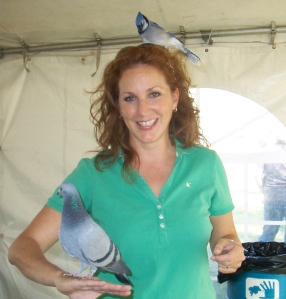
Me training Francis the pigeon and Pete the blue jay at 2010's Meet The Flockers annual fundraiser for Nature's Nursery.
put to use in giving live flight demonstrations at a fundraiser with her and Pete, the blue jay.
In wrapping up this post, I’d like to finish with the video of how this training is also incorporated in training two Red-Tailed Hawks. You can easily see here also how this can be incorporated in how we would use this to train two parrots at home. We often call both of the Red Tails to the front perch in the enclosure to begin training. I am still working on getting the one used to a new trainer. In order to do this, the one Red Tail seems to give more behaviors if the other Red Tail is on the front perch with her. The problem we were running into was that the other Red Tail seemed to hog all the food. Another hurdle in the journey, but not one that can’t be figure out. So now we cue them both up to the front, ask the food hog to station, reward, and then train the other. This video was taken almost two years ago to the day. Kamikaze is the food hog on the left and Kamali is the one on the right. This video was taken back when I was the only one training. This was Kamili’s first time ever flying voluntarily to a glove. I was so excited but could now scream and jump for joy like I wanted to.
In this video you will see me reward Kamikaze for doing exactly what I want her to…..staying right there. I then turn to Kamali and call her to my glove. When she goes back, I turn to grab more food to once again reward Kamikaze for staying put while I trained the other.
Once I train an animal using positive reinforcement training, a piece of my heart goes to that animal. Positive reinforcement training paves a new pathway of communication between you and the animal, one the animal grows to respect and often times shows behaviors of wanting more. This is why I continue to train as many birds a week as I do. It makes a huge difference in their lives and when many of their choices lie in my hands, I choose to continue to offer this form of enrichment to them. I like to pay it back to them for allowing me to learn from them. They are nothing short of fascinating and I respect every ounce of that.
